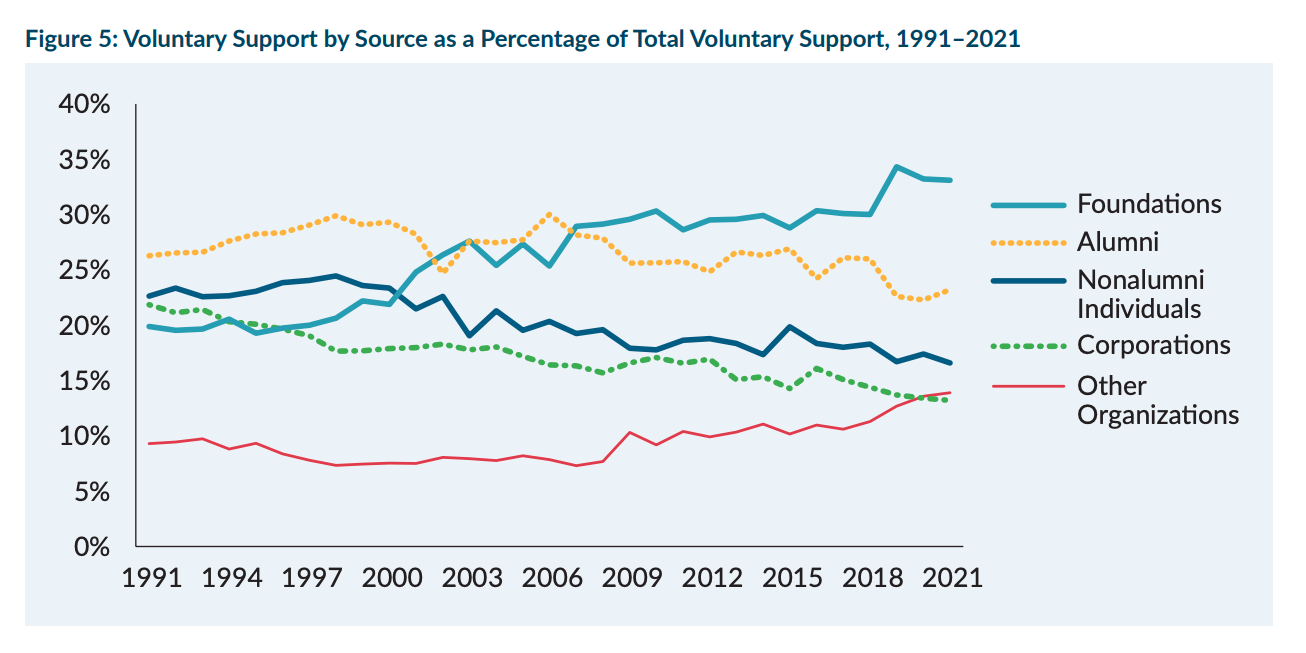You have /5 articles left.
Sign up for a free account or log in.

Ja_inter/Getty Images
Charitable giving to U.S. colleges and universities increased by nearly 7 percent in fiscal year 2021, according to the latest Voluntary Support of Education survey by the Council for Advancement and Support of Education. Total giving to U.S. institutions grew to $52.9 billion, up from $49.5 billion the year prior—a 5.1 percent increase after adjusting for inflation.
The survey, released Wednesday, includes information about charitable gifts and grants to higher education institutions from private sources during fiscal year 2021, which began on July 1, 2020, and ended on June 30, 2021. More than 860 institutions participated in the survey, representing 27.2 percent of U.S. colleges and universities but 83.8 percent of total voluntary support for higher education during that year.
Combined, donations from foundations and alumni accounted for 56.3 percent of higher ed giving in fiscal 2021. Alumni donations rose by 10.8 percent.
“This period covered the depths of the pandemic, so you hope that people are thinking that key institutions are very important. They’re remembering formative parts of their lives and want to support institutions,” said Amir Pasic, dean of the Lilly Family School of Philanthropy at Indiana University. “That’s something to watch—the alumni pattern—because that is, in many ways, the future indicator of giving.”
Alumni giving for capital purposes—which includes gifts for endowments; gifts of or for property, buildings and equipment; gifts to loan funds; and “irrevocable deferred gifts”—grew by 23.4 percent. Gifts to endowments, which often pay for scholarships, made up the largest share of that increase.
A strong economy during fiscal 2021 bolstered this type of giving, Pasic said. Donors often give to institutions at the end of the calendar year or the end of the academic year, according to the survey, and the economy was strong at both points.
“The overall stock market was going up and people were making those long-term investments that they’ve been talking about for some time,” Pasic said.
Nearly 400 institutions reported receiving gifts of stock in fiscal 2021. The number of such gifts rose by 6.2 percent in that time, and their value increased by 13 percent, according to the survey.
Unrestricted gifts—which make up about 7 percent of total giving—rose by 30 percent in fiscal 2021.
“I’ve never seen this leap in unrestricted giving,” said Ann Kaplan, senior director of the Voluntary Support of Education survey.
The unprecedented growth in this category is likely due to the large, no-strings-attached donations from author and philanthropist MacKenzie Scott and former New York City mayor Michael Bloomberg. Scott donated nearly $7 billion to nonprofits and higher education institutions—including historically Black colleges and universities, community colleges, and tribal colleges—in 2020 and 2021, though it’s not clear exactly how much of that was counted in this year’s survey. The money was unrestricted, and institutions could spend it as they saw fit.
As a result, associate degree–granting institutions reported a 52.5 percent increase in donations in fiscal 2021, according to the CASE survey. It’s possible that Scott’s unrestricted giving could inspire a trend, Pasic said.
“Something like this catches a lot of attention, and people are maybe doing more to support the core of an institution rather than trying to control what it’s doing,” Pasic said. “It’s hard to say whether their giving is going to have a further demonstrated effect.”

Other organizations, a category that includes donor-advised funds, continue to outpace corporations on donations to higher education. This trend began last year, when other organizations gave more to higher education institutions than corporations for the first time.
About half the survey respondents reported information about giving from donor-advised funds. At those institutions, gifts from such funds made up 81.8 percent of gifts from other organizations. Next year, CASE will break out donor-advised funds as a separate giving category, the survey stated.
Nine institutions reported single gifts of $100 million or more in fiscal 2021. Combined, those gifts totaled $1.46 billion.
“Based only on what we know about the economy in the first half of the 2022 fiscal year, we would expect giving to continue to rise, but not at the same level as it did in 2021,” the report stated.




